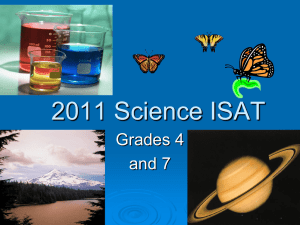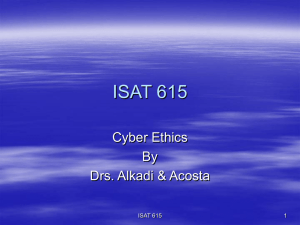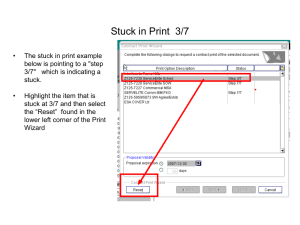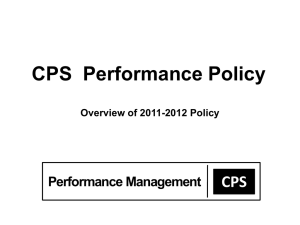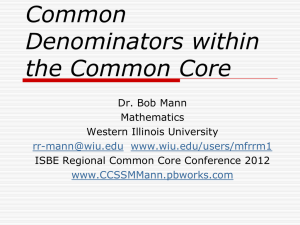Power Standards and SMART GOALS
advertisement
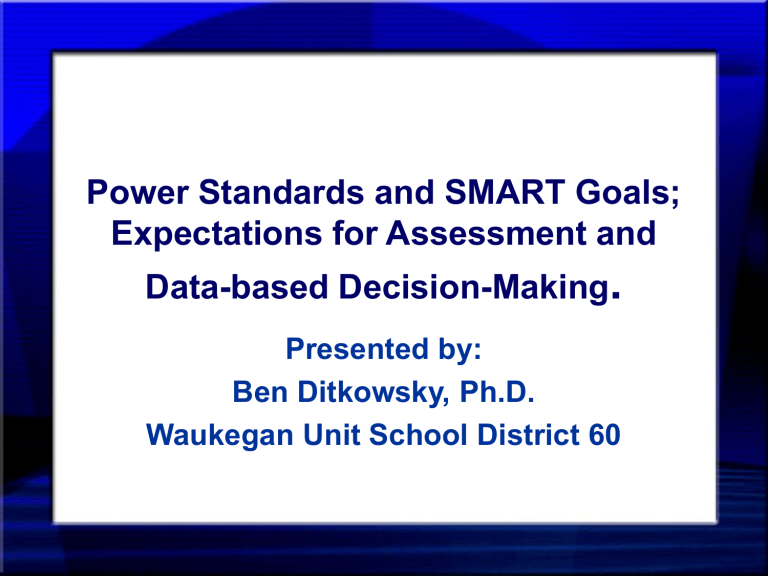
Power Standards and SMART Goals; Expectations for Assessment and Data-based Decision-Making. Presented by: Ben Ditkowsky, Ph.D. Waukegan Unit School District 60 Power Standards • A power standard refers to those few things that are really important to teach (Reeves). – BIG IDEAS (Kame’enui & Carnine) – Enduring understandings (Wiggins & McTigue) • The key question here seems simple: • What is it that we want students to know and be able to do? The practical reality of NCLB If we are going to be able to “leave no child behind” the state standards, then we are going to have to have a way of determining how far behind they are, from where we expect them to be, so that we can do something to accelerate their academic growth. …a way of determining how far behind they are, from where we expect them to be That means we need to use data to make decisions Increase Monitor Identify Promote To ensure decide adjust student apretest new student teacher teaching who student filecompliance goals has progress reflection anxiety as for failed “at are students –risk” to not for and meet aempty goal goal who standards setting have Plan Grade Meet Lock and students district ahigh group into for and apractices instruction send group home Make –folders stakes decision based exceeded (grade retention) expectations on one test Uses of data? + - Good Use Poor Use Plan and group for instruction Monitor student progress for a goal Identify a student as “at –risk” Identify new goals for students who have exceeded Promote student reflection and goal setting To adjust teaching practices Grade a pretest and send home To ensure file folders are not empty Meet district compliance Lock students into a group Make high – stakes decision based on one test To decide who has failed to meet standards (grade retention) Increase teacher anxiety When we use data we need to FOCUS: Things to consider • Entry level skills – If students come in with less skill than we expect then we need to get them to learn more with the same amount of time. • Efficiency and Effectiveness of Instruction – Time on task – Intensity of instruction • Data-based decision-making – Frequency of Assessment – Use of data to drive instructional decisionmaking Entry Level Skills More Skill Less Skill • Typical students have a benefit over low performing students. • They come in higher, so they don’t need to gain as much • Keep in mind that we need to make sure students have prerequisite skills Instruction More Skill Less Skill • To make up the difference, instruction should: – Be focused on the goal – Maintain student time on-task – Provide sufficient practice to ensure students have the opportunity to learn Assessment • The more dire the student needs, the more carefully we should watch their progress. • When students are not progressing, we need to change what they receive in terms of instruction. Monitoring progress requires us to pay attention • Is the instruction working? • Is it intense enough? • Do we need to change what we are More doing? Skill Less Skill Use Assessments from the Curriculum • To determine when to change instruction More Skill Less Skill • Rule: 3 data points below the aim-line Continuously Evaluate • Is it working now? More Skill Less Skill • Well enough to meet the goal? Continuously Evaluate • Is it working now? More Skill Less Skill Set Goals, and make them smart! •• Goals should be SSpecific and Strategic •• Goals should be Observable and M Measurable •• Goals should be Acceptable Action oriented and Attainable A •• Goals should be Realistic and RRelevant •• Goals should be Trackable and TTime-bound How do we know what goals to set? Use Power Standards: What is it that we want students to be able to DO? Curriculum-Based Measurement • Does how quickly a student can orally read relate to how well they do on ISAT? • Will a 5th grade student who… – … reads 120 cwpm meet standards? – What about a student who can read 150 cwpm, will they meet? Think – Pair -Share 1. Does fluency matter? Yes/No 2. How many words should a student in your class be able to read in a minute? 3. Why do you think so? Does Fluency really matter? 1. Does it matter? Yes/No 2. How many words should a 5th grade student read in a minute? Let’s consider some data… How many words can they read in a minute? • How many correct words did 5th grade students read in one minute? • Does the number of words that students can read in one minute relate to how well they do Mark read 175 words on the ISAT? Dorothy read 225 words Sarah read 147 words Kelsey read 120 words Let’s reorganize things • Some times we need to change the way we look at things before we can FOCUS. Setting up a chart to compare scores Grade 5 240 220 200 180 160 Exceeds Before ISAT testing what we knew was how Meets Exceeds fast students read a grade level passage. ISAT Below 140 Meets 120 Below Warning 100 80 Warning Dorothy read 225 words Mark read 175 words Sarah read 147 words 60 Kelsey read 120 words 40 20 0 290 280 270 260 250 240 230 220 210 200 190 180 170 160 150 140 130 120 110 100 90 80 70 60 50 40 30 20 10 0 Setting up a chart to compare scores Grade 5 240 220 200 Exceeds 180 Meets 160 Below ISAT 140 120 Warning 100 80 60 40 20 0 290 280 270 260 250 240 230 220 210 200 190 180 170 160 150 140 130 120 110 100 90 80 70 60 50 40 30 20 10 0 R-CBM A note about “Scatter – Plots” Scatter-Plot can help us to see – How scores from two different tests relate to each other. – Where we should set cut-points for students meeting expectations – How we can increase student’s chances to meet ISAT Standards. Looking at relations Grade 5 240 How did she do? 220 Dorothy read 225 Words in a minute And Dorothy obtained a 169 on ISAT 200 Exceeds 180 Meets 160 Below ISAT 140 120 Warning 100 Let’s see how Dorothy did on ISAT… 80 60 40 20 0 290 280 270 260 250 240 230 220 210 200 190 180 170 160 150 140 130 120 110 100 90 80 70 60 50 40 30 20 10 0 BDitkowsky@Waukeganschools.org R-CBM Let’s consider… Grade 5 240 220 200 Exceeds 180 Meets 160 Below ISAT 140 120 Warning 100 80 60 40 20 0 290 280 270 260 250 240 230 220 210 200 190 180 170 160 150 140 130 120 110 100 90 80 70 60 50 40 30 20 10 0 R-CBM Students who read less than 120 correct words per minute Grade 5 240 She read 120 words correctly in a minute She obtained a score of 150 on ISAT 220 200 Exceeds 180 Meets 160 Below ISAT 140 120 Remember Kelsey? Warning 100 80 60 100% of (62, 5th grade) students who read less than 120 words 20 per minute were below state standards on ISAT 40 0 290 280 270 260 250 240 230 220 210 200 190 180 170 160 150 140 130 120 110 100 90 80 70 60 50 40 30 20 10 0 R-CBM Students who read less than 130 correct words per minute Grade 5 240 220 200 Exceeds 180 Meets 160 Below ISAT 140 120 Warning 100 80 60 40 100% of (62, 5th grade) students who read less than 130 words 20 per minute were below state standards on ISAT 0 290 280 270 260 250 240 230 220 210 200 190 180 170 160 150 140 130 120 110 100 90 80 70 60 50 40 30 20 10 0 R-CBM Students who read less than 140 correct words per minute Grade 5 240 220 200 Exceeds 180 Meets 160 Below ISAT 140 120 Warning 100 80 77% of (62, 5th grade) students who read less than 140 words 60 per 40 minute were below state standards on ISAT 20 0 290 280 270 260 250 240 230 220 210 200 190 180 170 160 150 140 130 120 110 100 90 80 70 60 50 40 30 20 10 0 R-CBM What can we infer about students who are not fluent readers and ISAT? (<150 cwpm) Grade 5 240 220 200 Exceeds 180 Meets 160 Below ISAT 140 120 Warning 100 80 60 th grade) students who read less than 150 words 75% of (62, 5 40 per minute were below state standards on ISAT 20 0 290 280 270 260 250 240 230 220 210 200 190 180 170 160 150 140 130 120 110 100 90 80 70 60 50 40 30 20 10 0 R-CBM Think – Pair - Share What are two reasons why you think the speed at which our students read influences their scores on high – stakes tests? 1.There is time to complete the test. 2. They don’t have to spend time decoding, instead they can spend time comprehending. Let’s consider just the students who read more than 150 correct words per minute And Dorothy? Grade 5 240 220 Remember Mark? 200 Exceeds 180 Meets 160 Below ISAT 140 120 Warning 100 80 60 th 90% 40 of (62, 5 grade) students who read more than 150 words per minute were above state standards on ISAT. 20 0 290 280 270 260 250 240 230 220 210 200 190 180 170 160 150 140 130 120 110 100 90 80 70 60 50 40 30 20 10 0 R-CBM Place your bets • If you were going to bet that a student was going to meet expectations on the ISAT who would you choose? – A student who reads 120 cwpm? • 100% of our sample did not – A student who reads 130 cwpm? • 100% of our sample did not – … 140 cwpm? Or 150 cwpm? • 77% and 75% of our sample did not – What about a student who reads more than 150 cwpm? • 90% of our sample of students reading more than 150 cwpm met State Standards. – Pick your student. Reading CBM: An Instructional Focus by grade level For 5th grade students • By April 2, 200x • When given a randomly selected passage from the 5th grade Reading Series and one minute to read • 90% of students will orally read • Specific • 150 words correctly with 95 to 98% accuracy • Measurable Consider the data: 90% of 5th grade students who read 150 words correctly met ISAT standards • Action-oriented • Relevant • Time-bound Think – Pair - Share What are two factors that WE CAN CONTROL, other than the speed at which children read, that might influence their scores on high – stakes tests? 1. Vocabulary 2. Comprehension strategies 3. Other Basic skills 4. Language skill 5. Test – taking strategies, etc… What about 3rd Grade? Grade 3 220 200 Exceeds 180 of students who read 92% of students 93% of students who100% read who read 140 CWPM met Standards 94 CWPM 115orCWPM more met or more ISAT met Standards ISATISAT Standards 160 9/14 : 64% of students who read less than 94 did not meet ISAT Standards Below 140 120 Warning Can you see a pattern? R-CBM 25 0 24 0 23 0 22 0 21 0 20 0 19 0 18 0 17 0 16 0 15 0 14 0 13 0 12 0 11 0 10 0 90 80 70 100 60 ISAT Meets Should Oral Reading Fluency be a FOCUS for third grade? Consider this: – 92% of 3rd students in the (2 school sample) who read more than 115 words correctly in one minute met ISAT standards. – Fewer than 10% of students who failed to read at a target rate of 85 cwpm met ISAT standards. • Make goals S, M, A, R, T By April 2, 200x, when given a randomly selected passage from the 3rd grade Harcourt Reading Series and one minute to read, 90% of 3rd grade students will orally read 94 words correctly with 95 to 98% accuracy Re-confirmation of data (Grade 3 N > 500) Curriculum-Based Measurement and High Stakes Testing Grade 3 (N =537) 220 27% 66% 90% 210 190 180 170 160 150 140 130 73% 10% 34% Reading (CWPM) 0 26 0 24 0 22 0 20 0 18 0 16 0 14 0 12 0 10 80 60 40 20 120 0 Reading ISAT Scale Score 200 Re-confirmation with data (Grade 5 N > 500) Curriculum-Based Measurement and High Stakes Testing Grade 5 (N =523) 220 36% 61% 88% 210 190 180 170 160 150 140 130 64% 12% 39% Reading (CWPM) 0 26 0 24 0 22 0 20 0 18 0 16 0 14 0 12 0 10 80 60 40 20 120 0 Reading ISAT Scale Score 200 What should we expect? • Some variation is expected in oral reading fluency depending on passage difficulty, but clear targets are supported: • Grade 3 – Fall - 60 is cause for concern 80 is a target – Winter - 75 is cause for concern 100 is a target – Spring - 90 is cause for concern 115 is a target • Grade 5 – Fall 95 is cause for concern 130 is a target – Winter - 125 is cause for concern 145 is a target – Spring - 140 is cause for concern 155 is a target What about Vocabulary? • A pilot for middle school Grade level Teams Identify critical vocabulary Student friendly definintions Vocabulary Matching - CBM 1 Directions: Science Vocabulary Matching You will have 5 minutes to work on this activity. Read through the definitions below. Beside each definition, write the number of the word that best matches that definition. Remember, not all of the words will be used. Name: Date: Definitions The planet you live on (sample) Anything that has mass and volume Force of attraction between two objects In an experiment, the part that is changed on purpose Force needed to change movement The maintenance of a stable internal environment The amount of matter in a given space; mass per unit volume Correct All of space In an experiment, the part that is measured Force of a moving object Way to compare things Study of genetics The process by which one or more substances undergo change to produce one or more different substances A series of steps that scientists use to answer questions and solve problems Relating to science A collection of organs that gather and interpret information about the body's internal and external environment and respond to that information. Living and nonliving organisms interacting Relationship among organisms A prediction based on available information. 18 4 16 5 14 20 1 7 10 11 3 17 22 13 8 6 26 12 21 25 Word Bank 1 density 2 respiratory system 3 Momentum 4 matter 5 manipulated variable 6 scientific 7 accurate 8 scientific method 9 immune system 10 Universe 11 responding variable 12 ecosystem 13 chemical reaction 14 Inertia 15 atom 16 17 18 19 Gravity Measurement Earth adaptation 20 homeostasis 21 Interaction 22 Heredity 23 reproduction 24 Volcano 25 hypothesis 26 nervous system Administration and Scoring Vocabulary Matching • VM Curriculum-Based Measurement can be individually or group administered. Teacher Student Reads standardized directions Reads for two to five minutes. Monitors student performance on practice items Writes the number of words matching definitions Monitors students while they take the test. Counts the total number of correctly circled items Does Vocabulary relate to how well students do on the state test? • How many students who obtained a score of fewer than 5 on a VM (5 minutes) measure met standards for grade 7 science? • How about 10? • What about more than 10 correct? 34% 65% 97% Does Vocabulary relate to how well students do on the state test? 60 Vocabulary and Science ISAT Meet DNM Likely NOT to Meet 40 Likely to Meet Standards 30 20 10 VM Score 20 18 16 14 12 10 8 6 4 2 0 0 No. Students 50 The Measurement Pool • What words will a successful student know by the end of the school year? • The student is likely to know some of the key words before you begin. • As the year progresses, more words are taught, and more words are learned How can writing be assessed at the classroom level A first grade classroom example, goals and data: By March 19, 200X, when given a writing prompt, 90% first grade students will write a complete sentence in the language of instruction that directly includes the prompt in the response with an explanation (quality). By December 19, 200X, when given a writing prompt, 90% of first grade students will write a complete sentence in the language of instruction. 7 88% met the goal 6 5 38% 4 50% 3 10% 2 1% 1 0 5 10 1% 15 20 25 30 35 40 45 50 55 60 65 Time 1 A complete sentence includes (1) a noun and a verb (2) begins with a capital letter, (3) ends with punctuation, (4) has a space between words. 5) To exceed means more than one sentence with 4 elements. By January 19, 200X, when given a writing prompt, 90% of first grade students will write a [part 1] complete sentence in the language of instruction that [part 2] directly includes the prompt in the response (quality). 93% met part 1 of the goal 77% met part 2 of the goal 7 6 57% 5 36% 4 7% 3 2 High Quality Indicator Beginning Quality Indicator Quality absent Insufficient quantity indicators 1 0 5 10 15 20 25 30 35 40 45 50 55 60 65 Time 2 A complete sentence includes (1) a noun and a verb (2) begins with a capital letter, (3) ends with punctuation, (4) has a space between words. (5) more than one sentence with 4 elements, What do we need to do when not everyone meets? • Meet with peers / peer mentors (Grade 1 Team meetings) • Instructional support • Increasing focus and intensity of instruction By January 19, 200X, when given a writing prompt, 90% of first grade students will write a [part 1] complete sentence in the language of instruction that [part 2] directly includes the prompt in the response (quality). 93% met part 1 of the goal 77% met part 2 of the goal By March 19, 200X, when given a writing prompt, 90% of 1st grade students will write a complete sentence in the language of instruction that directly includes the prompt in the response with an explanation (quality). 7 6 78 % 68% 5 22% 4 3 2 High Quality Indicator Beginning Quality Indicator Quality absent Insufficient quantity indicators 1 0 5 10 20 15 25 30 35 40 45 50 60 65 70 Time 3 A complete sentence includes (1) a noun and a verb (2) begins with a capital letter, (3) ends with punctuation, (4) has a space between words. (5) more than one sentence with 4 elements, Goal setting at the Grade level A Kindergarten Center example… Making Instructional Decisions based on Data 1. Identification of Needs 2. Validate Needs What is thethe goal of instruction? does student need?what Is the difference between How implementation integrity be ensured? What will be used? Dowill wematerials have enough data to confirm or is expected and what is occurring? Was the intervention plan successful? How progress be monitored? refutewill a hypothesis? 5. Plan Evaluation and Modification 4. Plan Implementation 3. Plan Development The Plan: Three Tiers of Intervention • Defined: A data – driven model for differentiated instruction for all students • Focus on what works – Scientifically Based Reading Instruction – In the context of a self – correcting model of decision-making • Identifies / verifies need then organizes support that students need Three Tiers, with an Emphasis on Prevention at Each Level • Tier III (FEW students) Tertiary Intervention – Reduce complications, intensity, severity of current problems • Tier II (SOME students) Secondary Intervention – Reduce current cases of academic and behavior problems • Tier I (ALL students) Primary Intervention – Reduce new cases of academic and behavior problems Students who need more… receive more Tier 3: Intensive Instruction Intensity of service Tier 2: Strategic Instruction Tier 1: Benchmark Instruction (Typical) Intensity of Need Tier 3: Intensive Instruction Intensity of service Tier 2: Strategic Instruction Tier 1: Typical Instruction Intensity of Need 2004-2005 Meeting Expectations: In Phonological Awareness By June 1st 200X, when given a DIBELS Phoneme Segmentation Fluency Probe, 95% of students will orally identify more than 10 phonemes per minute (Emerging phonological awareness or better). Sixty-percent (60%) of Kindergarten students will identify 35 or more phonemes per minute (Established Phonological Awareness). 60 Three Tiers in action 50 PSF Intensity of service Student: Jen • September: Tier 3 • October: Strategic Monitoring • Successful intervention confirmed with progress monitoring • December: Tier 1 Corrects 40 NWF 30 20 ISF 10 LNF 0 Fall Benchmark Oct Nov Dec Jan Winter Benchmark Tier 3: Intensive Instruction Tier 2: Strategic Instruction Tier 1: Typical Instruction Intensity of Need Feb Mar Monitoring progress Think graphically How much or how many? What is your goal? What should progress look like? Keep changing until the data Collect and graph data! look the way you expect them If data do not match the to look! expected course, change something! Collect enough data to be reasonably confident that you know baseline PLEP (e.g., the median of 3) Time If data don’t show growth change something! Leaving No Child Behind • We agree with the goal of No Child Left Behind – Safe schools – Qualified teachers, etc. – All children reading at grade level • The practical reality is that while we may not be able to demonstrate on level results on State tests, SMART goals will show us which students need more/different instruction to improve their rate of progress. • SMART goals will empower teachers and allow them to celebrate their success with students. BIG IDEAS • • • • Determine your power standards set smart goals Monitor progress If it’s not working, or it’s not working well enough change it BIG IDEAS • There are things that we can monitor that can help us see how we are going to do. – Whether we are talking about student academic achievement, appropriate behavior, or diffusion of innovations – the first step is identifying specifically what we are going to measure (Power Standards). • We know that once we have the Basics, – Some need more to “meet” expectations. – And it is always nice to exceed. • We can be reasonably confident when we answer the question, “How are we doing?” before answering “How did we do?” …and just for fun, how about a high school example Cumulative (estimated) probability of meeting standards on P S A E The relation between A C T and meeting standards on P S A E 100% 90% The odds of meeting standards on PSAE for a student who scored 19 on ACT is 58.7% 80% 70% 60% 59% 50% 40% 30% 20% 10% 0% 0 2 4 6 8 10 12 14 16 19 18 20 22 24 A C T Math Score (2004) 26 28 30 32 34 A C T Cut scores for Reading and Science Reading Predicted ACT SCORE probability 2 0.0% 5 0.0% 6 0.0% 8 0.1% 9 0.2% 10 0.4% 11 0.8% 12 1.7% 13 3.4% 14 6.7% 15 12.9% 16 23.3% 17 38.4% 18 56.2% 19 72.5% 20 84.4% 21 91.7% 22 95.8% 23 97.9% 24 99.0% 25 99.5% 26 99.8% 27 99.9% 28 99.9% 29 100.0% 30 100.0% 31 100.0% 32 100.0% 33 100.0% 36 100.0% Substantial jumps in probability of meeting standards for Reading and Science (PSAE) were obtained based on ACT as well Approximately 90% of students who score 21 on any given sub-test meet standards on PSAE Science Predicted ACT SCORE probability Mean 7 0.0% 8 0.0% 9 0.0% 10 0.0% 11 0.0% 12 0.0% 13 0.0% 14 0.0% 15 0.1% 16 0.6% 17 2.6% 18 10.0% 19 31.8% 20 66.2% 21 89.2% 22 97.2% 23 99.3% 24 99.8% 25 100.0% 26 100.0% 27 100.0% 28 100.0% 30 100.0% 32 100.0% 33 100.0% So what does this tell us? FINDINGS The probability of meeting PSAE standards increase by nearly 30% by increasing from an ACT score of 17 to 18 in Reading; 18 to 19 in Math; and 19 to 20 in Science. Approximately 90% of students obtaining a score of 21 met standards regardless of the subject area. These findings are reliable - Analysis of a data set representing more than 10,000 11th grade students resulted in nearly identical findings IMPLICATION Although this is not causal (i.e., 19 does not cause PASE = Meet), the dramatic increase in probability does compel us to investigate this relation. ACTION Question Is there something that teachers can do to increase the chances of students obtaining a score of 18,19,20 (for Reading, Math, Science) on ACT? FOCUS We can use the practice ACT data to drive the focus of instruction! On which type of item ought we focus? • All items were examined and sorted according to difficulty. • The raw score equating to 21 was determined. • Items were coded as Most difficult, Difficult, FOCUS and Easiest Suggestion: Use the actual practice test, examine the items as a team and with students to determine why those items were missed. Don’t teach the test, but do With which students ought we focus and on what? All scale scores were computed. • • Scores were compared with probabilities to designate the risk status of students – regarding the likelihood of meeting standards on PSAE – based on data and a little guessing. • Scores were sorted by class – English, Science, Math, unidentified class and – color-coded. High Risk Likely to be on academic warning Indeterminate Risk May need to assess further, strategize instruction Low Risk Maintain current program Negligible Risk Likely to meet PSAE if it were given today HR IR LR NR Suggestions • Use the data to begin to strategize who needs how much of what. • The more you analyze the actual test the more you will be able to assist your students in being ready for the concepts that are being tested
